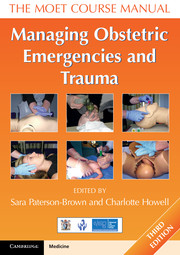Book contents
- Frontmatter
- Dedication
- Contents
- Working Group
- About the authors
- Acknowledgements
- Abbreviations
- Section 1 Introduction
- Section 2 Recognition
- Section 3 Resuscitation
- Section 4 Trauma
- Section 5 Other medical and surgical emergencies
- Section 6 Obstetric emergencies
- 24 Pre-eclampsia and eclampsia
- 25 Major obstetric haemorrhage
- 26 Caesarean section
- 27 Placenta accreta and retained placenta
- 28 Uterine inversion
- 29 Ruptured uterus
- 30 Ventouse and forceps delivery
- 31 Shoulder dystocia
- 32 Umbilical cord prolapse
- 33 Face presentation
- 34 Breech delivery and external cephalic version
- 35 Twin pregnancy
- 36 Complex perineal and anal sphincter trauma
- 37 Symphysiotomy and destructive procedures
- 38 Anaesthetic complications in obstetrics
- Section 7 Triage and transfer
- Section 8 Human issues
- Index
34 - Breech delivery and external cephalic version
- Frontmatter
- Dedication
- Contents
- Working Group
- About the authors
- Acknowledgements
- Abbreviations
- Section 1 Introduction
- Section 2 Recognition
- Section 3 Resuscitation
- Section 4 Trauma
- Section 5 Other medical and surgical emergencies
- Section 6 Obstetric emergencies
- 24 Pre-eclampsia and eclampsia
- 25 Major obstetric haemorrhage
- 26 Caesarean section
- 27 Placenta accreta and retained placenta
- 28 Uterine inversion
- 29 Ruptured uterus
- 30 Ventouse and forceps delivery
- 31 Shoulder dystocia
- 32 Umbilical cord prolapse
- 33 Face presentation
- 34 Breech delivery and external cephalic version
- 35 Twin pregnancy
- 36 Complex perineal and anal sphincter trauma
- 37 Symphysiotomy and destructive procedures
- 38 Anaesthetic complications in obstetrics
- Section 7 Triage and transfer
- Section 8 Human issues
- Index
Summary
Objectives
On successfully completing this topic, you will be able to:
discuss the risks and benefits of external cephalic version
understand the techniques of external cephalic version
discuss the risks and benefits of vaginal breech delivery
understand the techniques of vaginal breech birth.
Introduction
The incidence of breech presentation is about 20% at 28 weeks but has dropped to 3% by term as most fetuses turn spontaneously. Breech presentation can be a consequence of fetal or uterine abnormality, or can occur by chance. It has been widely recognised that there is higher perinatal mortality and morbidity with breech presentation, principally owing to prematurity, congenital anomalies and birth asphyxia. Breech presentation, whatever the mode of delivery, is a signal for potential fetal handicap and this should inform antenatal, intrapartum and neonatal management. CS for breech presentation has been suggested as a way of reducing the associated fetal problems and in many countries in northern Europe and North America CS has become the most common mode of delivery in this situation.
External cephalic version
External cephalic version (ECV), the manipulative transabdominal conversion of the breech to cephalic presentation, has been practised since the time of Hippocrates and through the European Middle Ages to modern times, although without much supporting evidence. In the late 1970s and 1980s, the procedure fell into disrepute but subsequent trials and the decline in the choice of vaginal breech birth has led to its wide reintroduction. It has been an RCOG audit standard for some time to offer ECV to women with a diagnosed breech presentation at term.
- Type
- Chapter
- Information
- Managing Obstetric Emergencies and TraumaThe MOET Course Manual, pp. 395 - 410Publisher: Cambridge University PressPrint publication year: 2014

